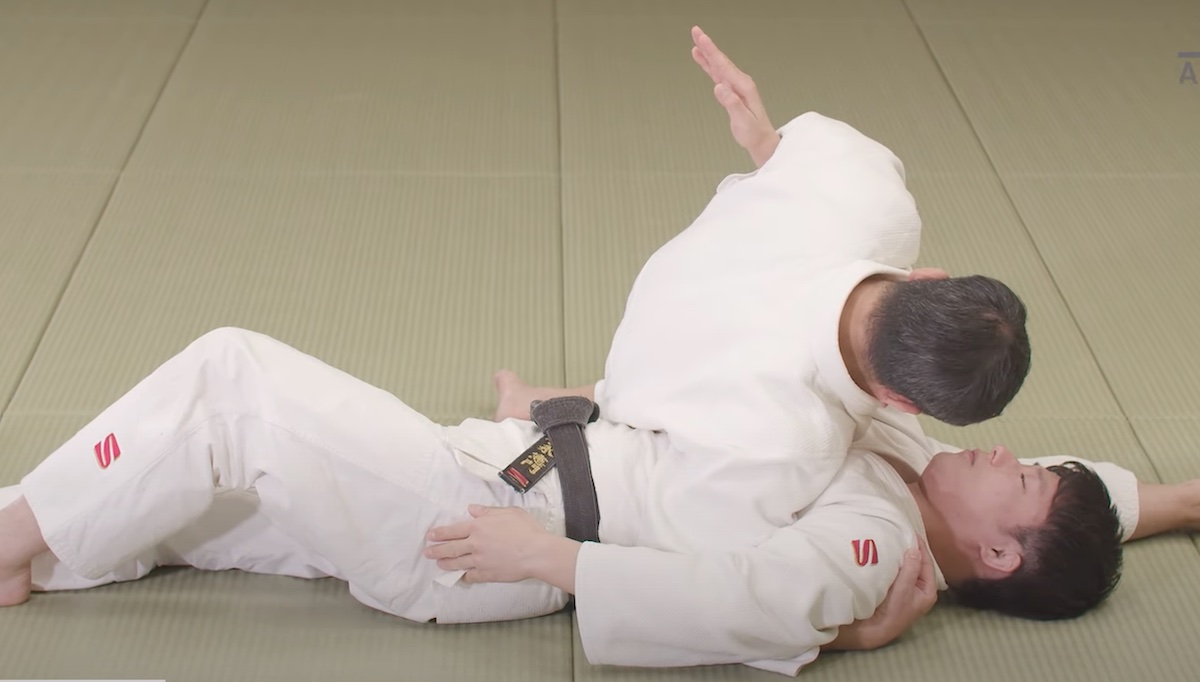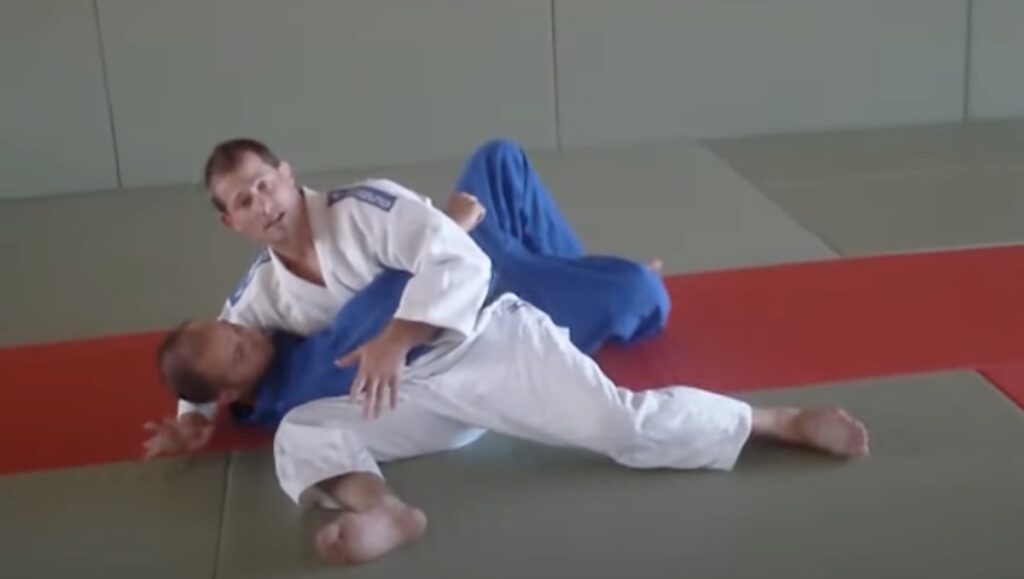Kesa Gatame Side-Control

If you’ve ever rolled with a Judoka in Jiu Jitsu, then you know that they love using heavy top pressure. Particularly using the kesa gatame style side-control.
If you’ve never used this type of side-control, here is everything that you need to know about kesa gatame. Detailing how you hold it, attacks, and tips for using this form of control.
What is Kesa Gatame?
Kesa gatame is a form of top control used in grappling, which is called side-control in Jiu Jitsu. Some also refer to this control as the “scarf hold position.”
To perform the kesa gatame side-control, you straddle the side of your opponent’s body. Placing the side of your midsection directly on your chest with your legs stretched out.
There are three variations of kesa gatame:
- Traditional kesa gatame with head and arm control.
- Kesa gatame with an underhook and overhook.
- Reverse kesa gatame, where you’re facing your opponent’s feet.
This style of side-control provides optimal control over your opponent, while giving various attacks to choose from.
Whichever style of grappling you practice, you should definitely consider using kesa gatame.
How to Hold Kesa Gatame?
Before we get into the various attacks from this side-control, you need to know how to hold it. Here is how you hold kesa gatame side-control.
The first thing that you need to know about holding this form of side-control is body positioning. Connect the side of your body right on the center of your opponent’s chest.
If you lean too far over your opponent, they will roll you over. Or if you’re too far off their chest, they will either recover guard or stand up.
Your legs also need to be specifically placed. Either have both legs slightly stretched out or placed your inside foot on the mat as an anchor.
Next is how you control your opponent’s head and arm. Grab above their elbow and lift it up as you hug around their head and also lift it up. Practice all of these steps to hold a secure kesa gatame side-control.
(Note: You can also cup your leg with the hand hugging your opponent’s head for better control and produce more pressure.)

Holding Other Kesa Gatame Variations
Holding the variations of kesa gatame have the same principles, but with a few different details. Here is how you hold the variations.
For the overhook/underhook variation, you need to be cupping your opponent’s arm with your underhook hand. Keeping both of their arms slightly off the mat to have a better hold of the position.
When you hold the reverse kesa gatame, hug your opponent’s body to close off space. Also scoot your body slightly up towards your opponent’s head to limit the movement of their arms.
Kesa Gatame Americana(w/Legs)
The first attack that we’ll detail is the americana arm lock with your legs. Also called the scarf hold armlock in catch and Sambo.
To start the setup, keep your arms connected, and place the blade of your wrist under your opponent’s elbow. Raising up on their elbow will create pressure that could make them tap or cause them to raise their arm.
Push your opponent’s arm towards your leg and hook it at your wrist. S-grip around your opponent’s head and pull up on their head as you pull your leg back to get the tap.
Kesa Gatame Straight Arm Lock(w/Legs)
Sometimes your opponent will straighten their arm to escape your americana lock with your legs. This gives you the opening to lock on a straight arm lock.
Hook your top leg over your opponent’s arm as you bring your bottom leg against their arm. Push your bottom knee up as you press your top knee down to lock on the submission.
Bicycle Kick Arm Lock
The straight arm lock may not work if your opponent keeps their thumb down. If this happens, you can go to the bicycle kick arm lock variation.
To do this arm lock, scoot your body a little deeper in as you come on to the sole of your inside foot. Your outside leg is going to kick down like you’re riding a bike to put on this arm lock variation.
Kesa Gatame Kneebar
When holding kesa gatame, a lot of BJJ guys will try to elbow escape and take your back. Attempting this escape gives you the opportunity for a kneebar.
When your opponent’s heel comes over your leg, you’re going to do a backstep with your inside leg. Then you’re going to let go of your control and grab your opponent’s leg with both hands at the ankle/heel.
Hug your opponent’s leg to your body, as you pinch their foot to your head. From there, just arch your hips to lock on the submission.
You can see the breakdown of the four previous techniques in this video.
Kesa Gatame Chest Compression
If you’ve seen the match from Metamoris 4 between Josh Barnett and Dean Lister, then you saw this choke. It’s a super powerful chest compression choke that’s similar to an arm triangle.
The setup starts from holding classic kesa gatame and cupping your thigh with your arm around your opponent’s head.
From here, you take off your arm control, swim your hand in, and pass your opponent’s arm across. Pinching their arm against your head and should to keep them from framing.
Next, switch your hand grips to a reverse S grip, and pull your opponent’s head to your chest. The pressure comes on quickly and your opponent feels like their head is getting squeezed off.
Kesa Gatame Arm Triangle
If you prefer, you can also go to a traditional arm triangle from the same control. Do the same swim move with your top arm to force your opponent’s arm across their body.
Next, keep your grips and switch your base to keep your body flat against the mat and next to your opponent. Take a deep breath and squeeze with your body to lock on the pressure and get the submission.
Watch this breakdown to see how to do the two previous techniques.
Kesa Gatame Escapes
Kesa gatame can be miserable to be stuck under. That is why you need to learn a few ways to escape this form of side-control.
Leg Hook
The first escape that you can use is the leg hook. It’s great if you have long legs and/or are flexible.
Simply turn to your side, hook your leg over your opponent’s leg, and escape the position. This is a good escape to use if your opponent’s outside leg is based up on their foot.
Bridge & Roll
If you can’t hook your opponent’s leg, the next escape that you should try is the bridge and roll. Start the technique by hugging your opponent’s belt or waist if you’re training No-GI. Keep a tight hold as you bridge your body to get your opponent up and roll them to the side.
Fram & Push
The frame and push escape is a good one to use when your opponent is holding side-control too low. All you do is frame on their neck, walk your feet out, push, and escape.
Blending Them All Together
In a live roll, you should aim to try and mix all of these escapes together. Never try to go to just one escape if it doesn’t work the first time you try it.
Go from one escape to the other and keep attempting them until you find a weak point in your opponent’s control.
Check out how to do all of these escapes in this breakdown.
Important Tips to Remember For Holding Kesa Gatame
Using kesa gatame is a great form of side-control to use, but you need to know how to properly hold it. Here are some important tips to remember for holding kesa gatame.
- Weight Centered: Keep your weight centered right on your opponent’s chest. If you’re off on either side, your opponent can easily escape.
- Arm Control: For the best control, hold your opponent’s arm above the elbow, and pull up on it.
- Leg Positioning: Don’t tuck your legs in or overly stretch them out. Your opponent will either roll you over or easily elbow escape out of side-control.
- Watch The Underhook: Be sure to defend the underhook. Your opponent will be trying to get the underhook to escape.
- No Space: Whichever style of kesa gatame you use, remember to give up no space between you and your opponent. Stay tight on them to keep optimal over them.






